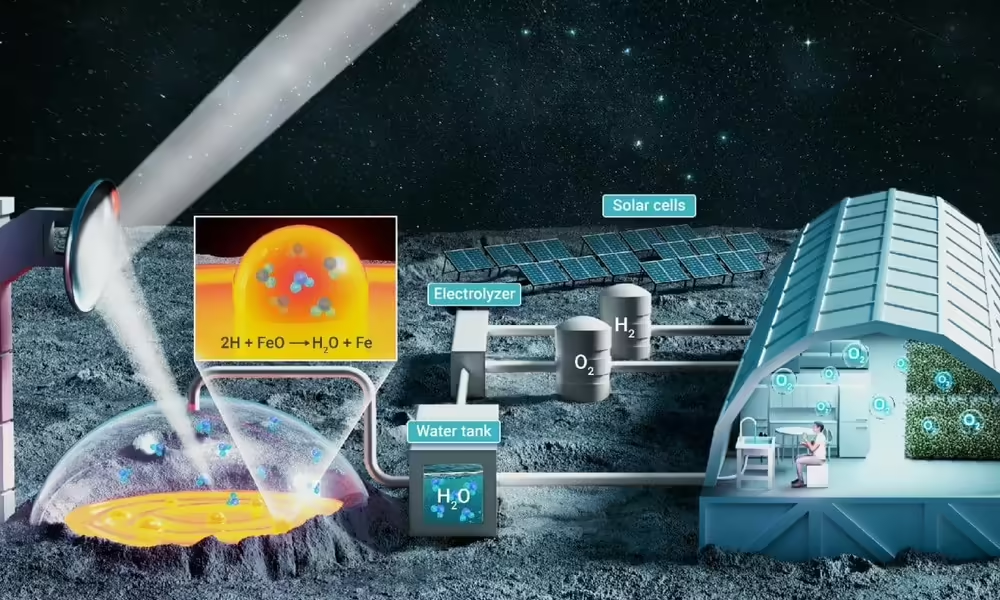Scientists extract water from lunar regolith
- August 25, 2024
- 0
Want to drink, wash, water the greenhouse and fly home? Just turn on the heat! A new technique proposed by Chinese scientists will allow the extraction of vital
Want to drink, wash, water the greenhouse and fly home? Just turn on the heat! A new technique proposed by Chinese scientists will allow the extraction of vital

Want to drink, wash, water the greenhouse and fly home? Just turn on the heat! A new technique proposed by Chinese scientists will allow the extraction of vital fluid directly from the lunar soil, even if the water concentration in it is minimal. Its effectiveness was successfully tested on regolith samples obtained as part of the Chanye-5 mission.
Water is undoubtedly important for any human activity. With its help we wash, prepare food and, of course, use it in its pure form – we drink it. Also, healing moisture is necessary for many technological and medical procedures. After all, it is relatively easy to obtain from water a highly efficient fuel pair for rocket engines (it can be electric): oxygen and hydrogen.
Since ancient times, human travel has been limited largely by the availability of potable water. If it is not possible to replenish its reserves by road, it is impossible to walk, drive, sail or fly safely for longer than the ruthless mathematics of the equation “barrel volume divided by the minimum daily consumption standard for all expedition members” allows. Cosmonautics is no exception, and it is very difficult to take a larger capacity with you; every kilogram of cargo counts.
This is why long journeys to interplanetary space or to waterless celestial bodies like Mars and the Moon are so technically challenging. That’s why any feasible way to replenish water supplies is so important to the future of spaceflight. Chinese engineers and scientists appear to have made a small revolution in the development of Earth’s natural satellite. They have experimentally confirmed that, using relatively simple technology, a lunar expedition can easily be supplied with local water for all possible applications.
The existence of water on the Moon is a closed question, there is but very little. Average content H2HE and hydroxide ion (AH –) in the lunar regolith varies from ten to a thousand parts per million. Simply put, in the most optimistic case, one kilogram of water can be extracted from one ton of local soil. The method proposed by researchers from the Celestial Empire allows this indicator to be exceeded by fifty times. Moreover, they worked with relatively “dry” regolith; in samples collected by the Chanier-5 probe, only 283 parts per million of water are found.
The fact is that most of the water currently discovered on the Moon is produced directly in the soil. The solar wind, one of the main components of which is protons, bombards the lunar surface. In it, these protons “steal” electrons from molecules in their path and turn into atomic hydrogen. Most of it instantly evaporates into space, but a few manage to react or get stuck in the crystal lattice of various minerals.
In the first case, atomic hydrogen has a chance to borrow oxygen from some oxide, and the result is a hydroxyl ion. When it “takes” another hydrogen atom, a water molecule is formed. Since the surface at the Chang’e-5 landing site is relatively young, it has not accumulated enough. A lot AH — or H2O. But there is always some more atomic hydrogen hidden in the nano-cavities of regolith minerals.
It is very simple to use it to obtain water: atomic hydrogen, when heated to 1200-1500 degrees, is good at reducing metal oxides (especially iron), and water becomes a by-product. Yes, the temperatures are high, but they can be reached, for example, with the help of a solar concentrator – a mirror that focuses reflected sunlight on a small area. Such installations can relatively quickly evaporate water from the lunar regolith on an industrial scale. And the waste of this process can be used as building materials or raw materials for metal mining.
A paper with a detailed description of the experiment, methodology and comprehensive analysis of the proposed technology was published in the peer-reviewed journal The Innovation. The authors of the study calculated that from one gram of regolith collected by Chanye-5, 51-76 milligrams of water and 157 milligrams of pure iron can be obtained. In other words, from one ton, at least 50 kilograms of drinking water are obtained. Chinese scientists say that this will be enough to provide liquids for fifty lunar colonies. Although the norm of one liter of water per person may seem a bit harsh, experience NASA shows: when working in a spacesuit you need at least two, or even more (240 milliliters for every hour of work).
In the case of older regolith or closer to the poles, it is reasonable to assume that water production per ton of rock could be much higher. And this is good news, even if it is not possible to fully supply the expedition with local resources, you can still count on replenishing supplies and taking a minimum from Earth. In addition, there is lunar permafrost – subsoil layers with an increased content of ice crystals (about 0.1-1 percent by mass) found in some subpolar regions. And when all this is taken into account, the future of lunar expeditions looks a little brighter.
Source: Port Altele
As an experienced journalist and author, Mary has been reporting on the latest news and trends for over 5 years. With a passion for uncovering the stories behind the headlines, Mary has earned a reputation as a trusted voice in the world of journalism. Her writing style is insightful, engaging and thought-provoking, as she takes a deep dive into the most pressing issues of our time.